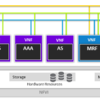 Last week, I introduced the NFV-based network diagram, and the complexity of all these pieces of software interacting. But how will they interact? This is all to be done via a Management and Orchestration (MANO) layer. Yes, there is MANO software entering the fray from established telecom vendors such as Oracle, HP and Ericsson, but also from new startups such as Cyan. Dialogic is working with many of the major players in this area, but the real leaders may yet still emerge. Until that happens, this area will be somewhat confusing and will slow things down. That’s normal with any new technology. Open Platform for NFV (OPNFV) should play a vital role here.
Last week, I introduced the NFV-based network diagram, and the complexity of all these pieces of software interacting. But how will they interact? This is all to be done via a Management and Orchestration (MANO) layer. Yes, there is MANO software entering the fray from established telecom vendors such as Oracle, HP and Ericsson, but also from new startups such as Cyan. Dialogic is working with many of the major players in this area, but the real leaders may yet still emerge. Until that happens, this area will be somewhat confusing and will slow things down. That’s normal with any new technology. Open Platform for NFV (OPNFV) should play a vital role here.
From a signaling perspective, the Diameter Signaling Controller (DSC) could play a vital role in signaling orchestration. All signaling would be going through the DSC anyway, so enhancing the DSC to play a more central signaling orchestration and security role could provide value. As NFV starts to take hold, software based DSCs are in a central position in the network regarding routing and protocol interworking. The DSC could therefore become a vital element in policy orchestration for NFV in general, just because it’s central to the Diameter flows that touch all the different VFNs. If there were server failures, application failures, or VNF failures, the DSC could be in the middle of that and start to orchestrate the signaling.
Another challenge will be scaling and performance of the NFV. Moving from specialized hardware that is optimized for a network function to commercial off the shelf servers running the software, and expecting the same performance, will take some effort. Dialogic has a lot of experience in this area, especially in the area of media processing. Dialogic has never had hardware assist for our software based media processor. Software based load balancers are required to get to the performance levels of specialized hardware. Many vendors will take time to address performance and it will be difficult for some. Some will make it forward, but new startups will likely also make their mark here. This entire change in paradigm will also likely prove to be a challenge and slow down NFV.
The move to NFV is upon us. There will be vendor winners and losers from this transition. But it’s not going to happen overnight, and there is much work to be done in the industry to enable this transition.












